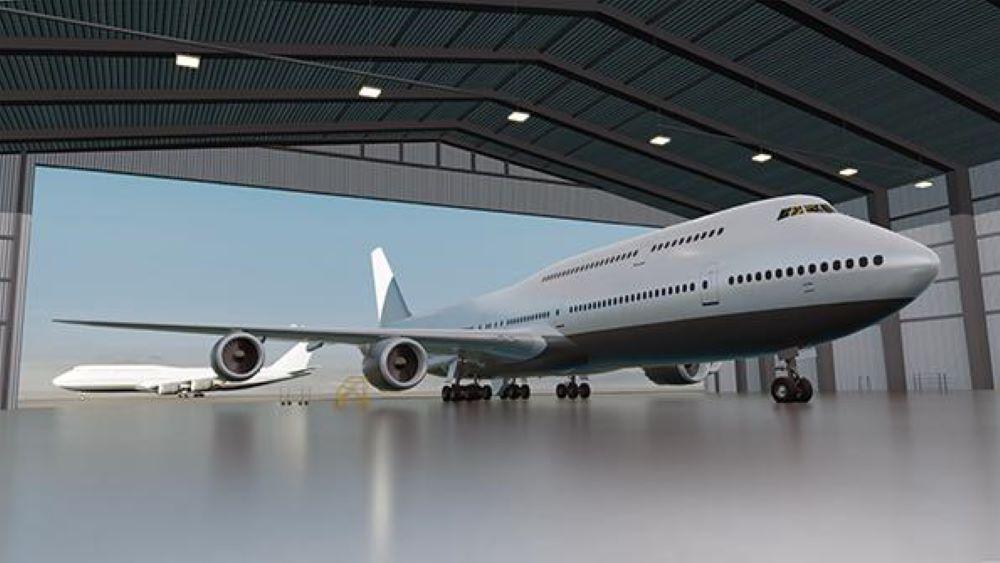This article is published in Aerospace Daily & Defense Report, part of Aviation Week Intelligence Network (AWIN), and is complimentary through May 08, 2024. For information on becoming an AWIN Member to access more content like this, click here.

SNC rendering of a 747 in its new hangar complex in Dayton, Ohio.
The U.S. Air Force has awarded Sierra Nevada Corp. (SNC) a $13 billion contract for its Survivable Airborne Operations Center (SAOC)—a contract that is by far the largest program for the privately held company.
SNC beat out traditional prime contractor Boeing for the program, which will replace the current E-4B Nightwatch fleet. The award is notable as SNC, whose traditional programs have been smaller aircraft modifications, will likely modify Boeing’s own 747-8i aircraft for the fleet.
The cost-plus-incentive fee contract, with a fixed-price-incentive-firm target, includes an initial award of $59 million. It covers the development and production of the SAOC Weapon System, including delivery of engineering and manufacturing development (EMD) aircraft, associated ground systems, production aircraft and interim customer support. Work is expected to be completed by July 2036.
The Air Force in a statement said development of SAOC is critical to ensure the nuclear command, control and communications capability. The commercial-derivative aircraft will be hardened and modified to meet military requirements. It will also integrate secure communications and planning capabilities with modern information technology.
Aviation Week first reported in August 2023 that Sierra Nevada Corp. was competing for the contract. The company built a new 90,000 ft.2 maintenance, repair and overhaul hangar. It plans to have four of the hangars, plus a 120,000-ft.2 paint facility. The construction is self-funded ahead of the SAOC program, along with potential work under the U.S. Navy’s E/A-XX Take Charge and Move Out program. For the latter competition, SNC has teamed with Collins Aerospace.
In a statement at the time, SNC said its position as a midtier, privately held company helps it remain competitive with speed and agility.
“We are small enough to be agile, but large enough to succeed with a highly skilled, motivated workforce,” SNC says.
The SAOC award is cost-plus for EMD, as the Air Force has largely moved away from fixed-price development. The contract’s nature is notable, as in December Boeing announced it was no longer in the running for the program under the current request for proposals, but it was not completely withdrawing if the conditions under the RFP changed.
“We are approaching all new contract opportunities with added discipline to ensure we can meet our commitments and support the long-term health of our business,” the company said at the time. “We remain confident our SAOC approach is the most comprehensive, technically mature and lowest-risk solution for the customer and Boeing.”
Attention at the time focused on the company’s position that it would avoid fixed-price development, but the cost-plus nature of SAOC does not apply.
Ahead of the contract, Lt. Gen. Richard Moore, the deputy chief of staff for plans and programs, told Aerospace DAILY that the small fleet planned for SAOC means that essentially the entire fleet is EMD aircraft. There would not really be a shift to fixed-price procurement since the fleet is so small.
“There is no one-size-fits-all contract, and part of the art of acquisition is picking the right contract for the right purpose,” he said in January.
A major sticking point with SAOC has been the procurement of intellectual property (IP) for long-term sustainment. Since the fleet is small, the long-term profit for contractors is in the support.
“The goal for us is to buy only the IP that we need. We want to buy the IP that we need for sustainment based on whatever the sustainment model is, but no more,” Moore says. “So, in the E-4B replacement, that’s a 747 platform. We don’t need the design of the wing, proprietary information that’s Boeing proprietary for a good reason. What we do need is the ability to maintain the airplane according to the sustainment concept that’s in the acquisition strategy, and we have to buy all of that.”
The Air Force has stood up a new office at Wright-Patterson AFB, Ohio, to focus on procuring intellectual property, Moore says.
SNC said in an August statement that the company’s history of aircraft modifications—including a recent program with Air Mobility Command that involved in-depth scans of its aircraft for communications modifications—highlights its different approach to sustainment.
“That really sets us apart in the industry,” the company says. “We create a digital data package, which is then shared with the government in full. This empowers the customer and significantly reduces life cycle sustainment and modification costs through competition.”
Ahead of the award, Air Force officials have raised concerns about the cost of SAOC increasing. In recent testimony to lawmakers, Air Force Secretary Frank Kendall says the price is increasing to the point where it is putting pressure on the broader Air Force budget.
The service is requesting $1.69 billion in its fiscal 2025 budget for research and development, with $9 billion planned over the next five years.
Andrew Hunter, the service’s assistant secretary for acquisition, told Aerospace DAILY in an April 16 interview that the service has not conducted its Milestone B process that would baseline the cost. However, there have been changes in the cost expectations since the first assumptions were made in the SAOC program’s early stages.
“In this case, of course, it costs more than we thought. So it’s still meaningfully different, but some of it is just what assumptions were used in putting together the funding profile. In the case of SAOC, there were just things that were left out,” Hunter says. “There were just program costs that weren’t recorded.”





